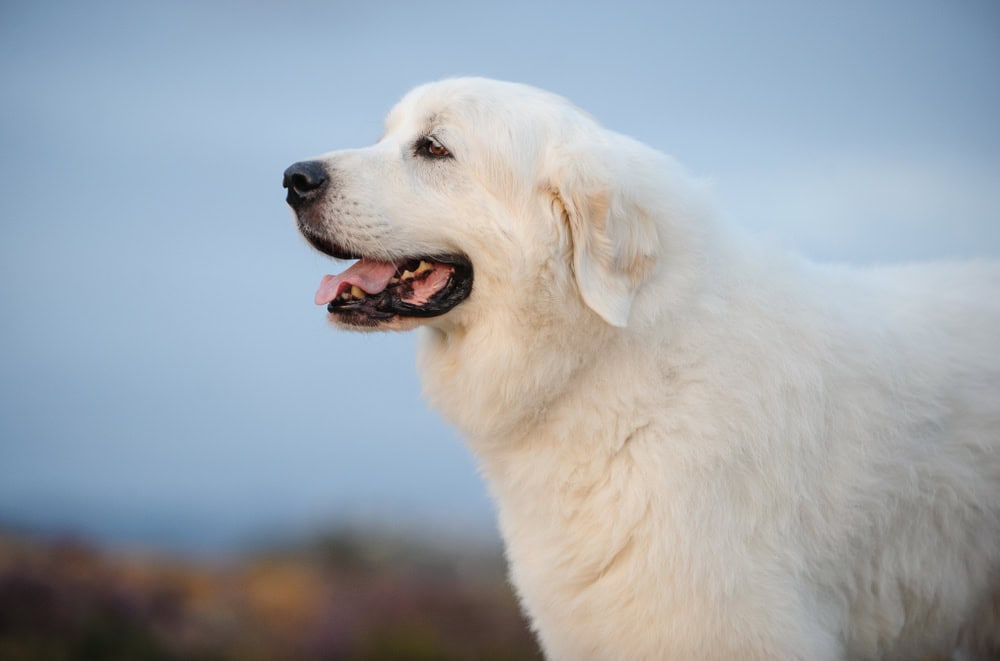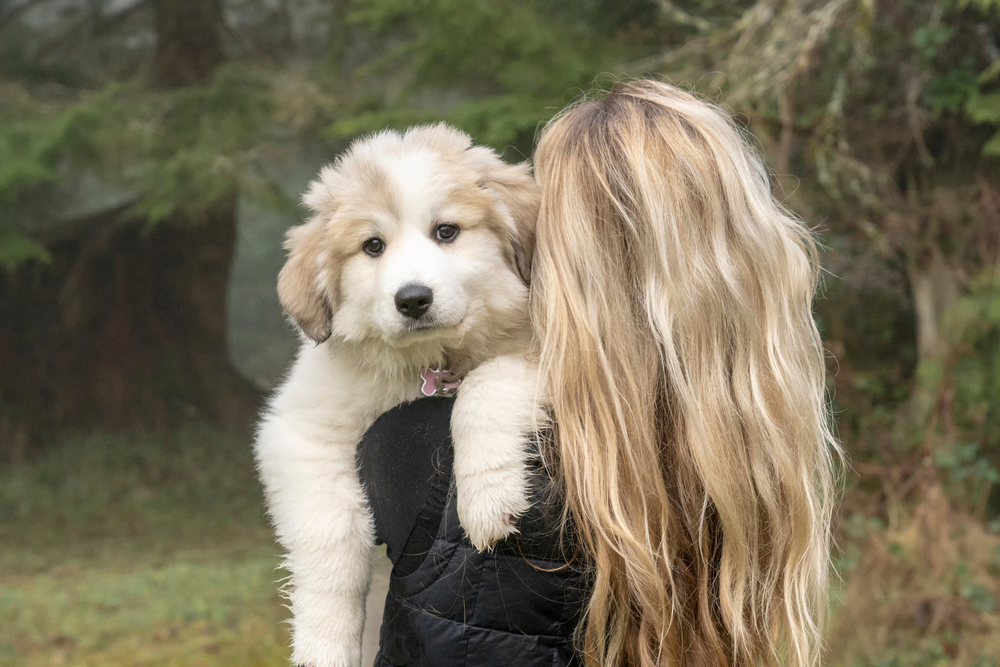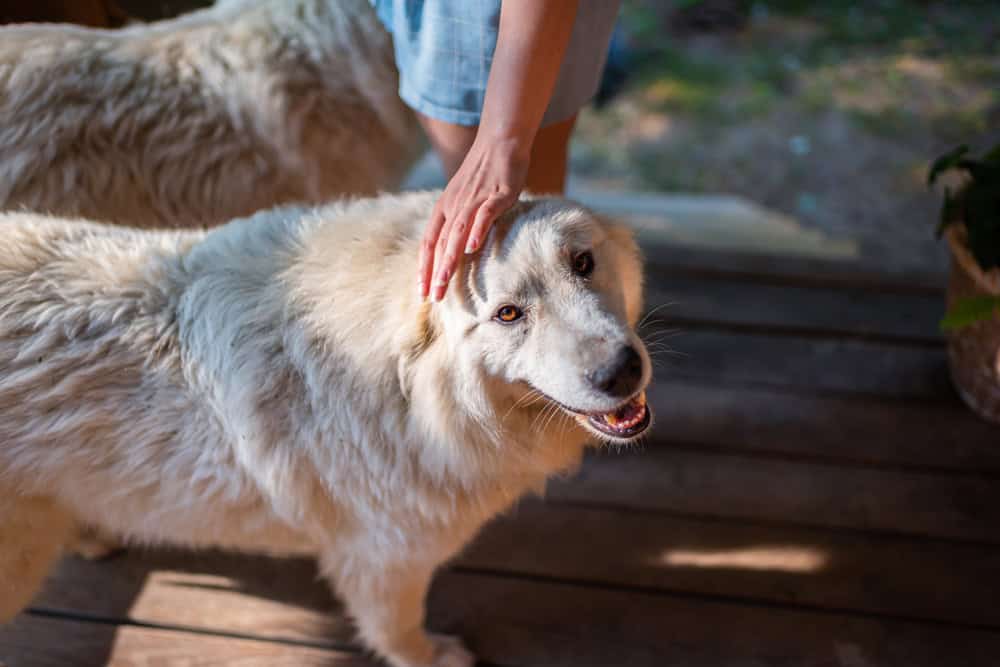Great Pyrenees are the type of dog to stop you in your tracks. Their pure white coat, tall height, striking eyes and fluffy fur are enough to catch anyone’s attention. This working dog ranks 66th on the AKC most popular breed list and has been a beloved breed for decades.
The Great Pyreenees, also referred to as a Great Pyr, is loved for their gentle, calm behavior and sweet disposition. There’s something about the breed’s sweet personality and aloofness that charms people, and it’s easy to see why.
The Great Pyr is known most as a working dog, specifically a livestock dog, but they are also great pets thanks to their gentle demeanor. They’re popular as a therapy dog, but also becoming more popular as a service dog. Essentially a calmer, bigger version of the Golden Retriever, there’s a lot to love about this breed, and they make a great match for service work. Let’s learn more about service dogs and why Great Pyrenees are a good candidate to be a service dog.
What are Service Dogs?

The definition of a service dog according to the U.S. Department of Justice as “dogs that are individually trained to do work or perform tasks for people with disabilities.” This is a very broad definition, and doesn’t quite clearly differentiate service animals from regular dog ownership.
Luckily, more legislation was provided on the definition of service dogs. The Americans with Disabilities Act (ADA) of 1990 gave a more specific definition for service dogs: “dogs that are individually trained to do work or perform tasks for people with disabilities. Examples of such work or tasks include guiding people who are blind, alerting people who are deaf, pulling a wheelchair, alerting and protecting a person who is having a seizure, alerting owners to a panic attack, reminding a person with mental illness to take prescribed medications, calming a person with Post Traumatic Stress Disorder (PTSD) during an anxiety attack, or performing other duties.”
Types of Service Dogs
There are many different types of assistance dogs for different disabilities. Service dogs can help with nerve damage, paralysis, spinal cord injuries, blindness, and more. While some disorders are physical, some are mental, such as elopement disorder, autism, brain injury, autism, etc. Service dogs help their handlers with many tasks, but there are a few main types of service dogs we will discuss in this article.
Service dog: A service dog is the most common type and is the broadest category. A service animal can help with many things, but in this category, it is most often pups offering assistance with physical disabilities or impairments.
- Guide dogs: These dogs are also known as seeing-eye-dogs and help people with vision loss navigate the world. A guide dog will help their handler avoid obstacles, open doors, maintain a steady piece, board public transport, etc. These are the oldest forms of service dogs, and date back to Pompeii, where illustrations show a blind man being led by a dog.
- Hearing dogs: These intelligent dogs assist their deaf handlers with sounds they cannot hear. They are trained to help their owners receive vital cues of sounds, including smoke or fire alarms, doorbells, door knocking, phones, alarm clocks, and even the person’s name.
- Medical alert dogs: These service dogs help owners suffering from seizures or epilepsy prepare for an upcoming seizure episode and keep them safe during it. Another type of service dog under this category is a diabetic assistance dog, who helps alert their owner when their blood sugar is low or can seek medical assistance if necessary. There are many other types of medical assistant dogs for dozens of diseases. Some dogs can now even sniff out
- Mobility assistance dogs: A mobility assistance dog is a type of service dog that helps humans with spinal injuries, leg injuries, or any injury that makes walking, standing or balancing difficult. These are typically larger breed dogs since they provide balance support for their handler. They help their human stay standing, open doors, walk, retrieve items, etc.
Psychiatric service dog: This special service dog assists people with mental disabilities or mood disorders. They have all the same rights as all the mentioned service dogs, but undergo specialized service dog task training to help their owners with mental or mood disorder needs. Some examples of this could be retrieving medication, providing comforting touches, finding a quiet place for their owner, making sure no one touches their owner, etc. These service dogs help with mental health issues rather than mobility issues.
Click the below video to learn more about psychiatric service dogs.
Therapy dog: A therapy dog is not a service dog, but instead a dog that provides emotional support and comfort to people in stressful situations. This is often a hospital or nursing home, but can also be schools, natural disaster sites, etc. They are not service animals as they don’t perform specific tasks for people with disabilities, but they do undergo specialized training, including passing an American Kennel Club Good Citizen test. Then, they visit anyone who could need comfort. They have a home and are a pet at the end of the day. Find out more about training your dog to become a therapy dog here. Therapy dogs provide important comfort to the patient, their family, and all around them.
Emotional support animal: An emotional support animal is a companion animal that provides emotional benefits to their owner. They do not undergo any special training, and are not a service animal. They do not provide assistance to any other people besides their owner, and mainly stay at home or can sometimes accompany their handler during travel. Any animal can become an emotional support animal with a doctor’s note, but they do not have the same rights as service dogs or assistance dogs. Newer laws have become more strict with emotional support animal’s ability to fly with their owners due to people pretending their emotional service animal is a service animal.
Emotional Support Dog vs. Psychiatric Service Dog: What’s the Difference?

While both emotional support dogs and psychiatric service dogs provide emotional support to their owner, only one is a recognized service animal, and that’s a psychiatric service dog. These dogs undergo specialized task training and have federally protected rights, such as the right to accompany their owner anywhere, including businesses, schools, non-pet friendly housing, on airplanes, etc. They learn specific tasks to help their owner. There is nothing they can’t do for their person. Emotional support dogs and others do not go through task training, so they are pets. To get a psychiatric service dog, you must be diagnosed with a disability and prescribed a service dog, who you will work with a trainer to train or train yourself, though we recommend working with a professional.
An emotional support dog only requires a letter of recommendation from a doctor. They are a pet who offers mental and emotional benefits to their owner, which can be very helpful, but they can’t accompany their owners in public places, nor do they have access on flights, in schools, etc. and have no federally protected rights. Dogs and cats are the most common types of ESAs, but any animal has the chance to become an ESA with a doctor’s note. They can’t help anyone but their owner, and don’t have any temperament or trainer requirements.
In modern days, emotional support animals are a hot topic due to their loose regulations. People commonly pretend their therapy dog or ESA is a service dog. They cite AKC papers or fake paperwork as proof of service dog status, which are just cons. They’ll bring their puppy or dog into stores with fake vests and cause disruptions and damage. Service dogs wear vests to set themselves apart, as they have a very important job and should be recognized as working dogs. Pretending a dog is a service dog is actually illegal in 20+ states and is very damaging to service dogs’ reputations. It makes life for people with disabilities much harder, and poses a challenge to service dog owners, making the conditions of service dogs worse.
Why Great Pyrenees?
The Great Pyrenees got its name from the mountain range in southwestern Europe, where they were long used as guardians of flocks. The breed evolved from a group of white mountain flock dogs that originated ten or eleven thousand years ago in Asia Minor. They have a long history, and likely plenty of crossbreeding over the centuries, but the white coat and herding tendencies remain true. Over time, they have herded sheep, pulled a cart, and much, much more. Over time, their calm nature made the Great Pyrenees breed a beloved family member for son, husband, wife, and all. They form strong bonds and are quite loving.
The Great Pyr breed is one of the largest dog breeds around. They’re recognized by the AKC as a giant breed, standing up to 32 inches tall at the shoulder and commonly weighing over 100 pounds. They have a life expectancy of 10-12 years, and are predisposed to the typical ailments a large dog faces, such as hip dysplasia. For a giant breed, this is a pretty good age.
Their coat is white, which is a breed characteristic, and very fluffy. They are notorious shedders and require a regular wash and groom. And we mean a lot of grooming, daily brushing is preferred as this is one of the most shedding dog breeds around. There are products specifically designed to help keep their beautiful white coat bright and shiny even!
The Great Pyrenees is a very calm breed. Unlike a Border Collie, who is also a harder, but energetic, the Great Pyr is notoriously quiet and calm, even as a puppy. They are extremely loyal, to their human and to their flock, and will work hard at their jobs, but also enjoy a good rest. A Great Pyrenees is a sensitive dog, and does best with an owner relationship where dog and human understand each other.
Great Pyrs are of average intelligence, and can be a bit stubborn. Working with a trainer is recommended for this breed thanks to their sometimes stubborn nature, especially if they are being adopted as a pet. While they are very loving, they are also one of the more aloof dog breeds and enjoy some time alone.
With a Great Pyreenees, you have a friend for life and a loyal companion through any and every thing. In history, they have always been the “peasant’s dog”. Most breeds belonged to royalty, but Great Pyrs were a people’s dog. Now, they are near the top of the list of the AKC most popular breed list, still sticking by man’s side.
Great Pyrenees as Service Dogs
A Great Pyrenees is a great size for a service dog to provide mobility assistance and balance support. Their size should also be considered though if their handler ever has to transport them themselves or during training. A 100+ pound dog has a lot of power.
Great Pyrenees are extremely loyal and fearless. They will do anything for their handler, which is a great personality trait of the breed. They have a quiet confidence about themselves, and are remarkably calm in any situation, even new ones.
The Great Pyrenees breed is also a bit strong-willed. A quick search of the breed brings up many amusing videos where they refuse to leave their flock, or even just a comfortable spot they’ve found outside or on the couch. This strong-willed nature can prove difficult during training, but also shows they are committed to their work, which is a positive trait. Our advice is to work with a trainer quickly to ensure your Great Pyrenees is able to listen and perform the tasks you need in your life.
Grooming should also be mentioned. Great Pyrs have beautiful coats, but they do require regular grooming and brushing, especially if they are working outside. They are prone to tangling and shedding, so allergens should also be considered.
Great Pyrenees thrive when they have space to roam and a job to do. They do best when providing a service for their human and benefit greatly from training. This is what makes them a good candidate as a service dog. They aim to please and have many pros as a service dog breed.
How to Get a Great Pyrenees Service Dog

Are you interested in having a Great Pyrenees as a service dog? Great Pyrenees are not a very common service dog, but they are a solid choice. You won’t find them in many service dog organizations, but they can be trained to become a great assistance animal.
First, you’ll want to make sure you are able to receive a service dog. Service dogs are only given to people with disabilities that hinder their quality of life. For a psychiatric service dog, you must consult with a licensed mental health professional. This is the only legitimate way to acquire a service dog. For physical disabilities, you must consult with a doctor in your area.
If they recommend a service dog, the next step is finding a service dog for you. Look at rescues in your local area to see if they have any Great Pyrs or Great Pyr mixes. Check out your local nonprofit organization rescues to see if you find any possible matches. If you adopt one or purchase one from a breeder, you will want to work with a service dog trainer or service dog program training to make sure your pooch becomes the best assistance dog possible.
If you go the route of a breeder, be sure to look for reputable breeders that stick to the breeds’ standards and treat their puppies and mothers ethically. This ensures you receive a healthy dog who will be the best assistant dog for you.
Conclusion
It’s clear to see why the Great Pyrenees is such a loveable, gentle giant. This remarkably calm breed is a great addition to any family, or to someone who needs a service animal. This breed is remarkably loyal, easy-going, and dedicated to their job, all vital aspects of a service dog.
Are you looking for a psychiatric service dog?
Here at CertaPet, we can help. CertaPet is an online telehealth platform that improves access to mental health care in the U.S. with a focus on providing services to individuals who are seeking animal assisted interventions as part of their treatment plan.
We are currently coordinating with dog trainers who specialize in the service animal space and who will soon work in tandem with our network of licensed mental health professionals to make the process of getting and training a psychiatric service dog affordable, convenient, and hassle-free. We’ll have more information available soon about our Psychiatric Service Dog Training options. In the meantime, you can take our FREE pre-screening below to see if you qualify for a PSD!
FAQs
Why do Great Pyrenees make good service dogs?
Great Pyrs are a good size for mobility assistance, very loyal, motivated by work, and extremely calm and friendly.
How do I get a psychiatric service dog?
First, you must consult with a mental health professional to see if you qualify. If you are diagnosed with a mental disability, you will begin your search for a dog and begin training
What does a psychiatric service dog do?
Every psychiatric service dog is specially trained for their handler, but some tasks they can accomplish include: fetching medicine, providing calming touches, leading their owner to a safe place, helping their owner calm down during an anxiety attack or PTSD episode, and much, much more.
